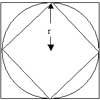Skip over navigation


Or search by topic
Number and algebra
Geometry and measure
Probability and statistics
Working mathematically
Advanced mathematics
For younger learners
Mean Geometrically
Age 16 to 18
Challenge Level 





- Problem
- Getting Started
- Student Solutions
 |
This involves nothing more than areas of right angled
triangles, using the symmetry in the diagram, and sines, cos's and
tan's.
Well done M.S. Ezzeri Esa from Cambridge Tutors College,
Croydon and thank you for this solution.
Let radius = $r$; $\angle AOD = \angle BOD = \alpha$
Area $ADBO$ = $2 ({1\over 2 }r^2 \sin \alpha) = r^2 \sin
\alpha$
Area $ABO$ = ${1\over 2}r^2 \sin 2\alpha = r^2 \sin \alpha
\cos \alpha$
Area $ACBO$ = $2({1\over 2}r^2 \tan \alpha) = r^2 \tan
\alpha$
(Area $ABO$). (Area $ACBO$) = $r^2 \sin \alpha \cos \alpha\ .\
r^2 \tan \alpha = r^4 \sin^2 \alpha ={\rm (Area ADBO)}^2.$
The area of $ADBO$ is the geometric mean of the areas of $ABO$
and $ACBO$
|
You may also like
Approximating Pi
By inscribing a circle in a square and then a square in a circle find an approximation to pi. By using a hexagon, can you improve on the approximation?
Spokes
Draw three equal line segments in a unit circle to divide the circle into four parts of equal area.

